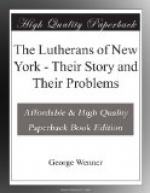Its first housefather was George Carl Holls, one of the brethren of Wichern’s Rauhe Haus near Hamburg. In 1886 he was succeeded by Pastor Gottlieb Conrad Berkemeier, who with the help of his wife, Susette Kraeling, has brought the institution to a position of great prosperity and usefulness.
[illustration: “The Wartburg at Mount Vernon”]
In the Nineteenth Century 1866-1900
Three factors combined to make this period eventful in our history: confessionalism, immigration and the transportation facilities that led to a Greater New York.
At the close of the Civil War we had 24 Lutheran churches on the territory now included in Greater New York. Two of these were English and the rest were German. At the close of the century the record stood: Yiddish, 1; English, 17; Scandinavian, 19; German and German-English, 60.
The tide of confessionalism which had been rising in Europe for half a century touched America in the forties and reached a high water mark during the period under review. The question of subscription to the symbols of the Book of Concord became the chief subject of discussion among our theologians.
In 1866 a number of pastors and churches, under the leadership of Pastor Steimle, severed their connection with the Ministerium for confessional reasons. They formed a new synod which adopted all the Confessions and took a firm stand in opposition to membership in secret societies.
The “Steimle” Synod, as it was usually called, disbanded in 1872, its members going, some to the Missouri Synod, others to the Ministerium. Their organ, the Lutherisches Kirchenblatt, was merged with the Lutherischer Herold.
Pastor Steimle died in 1880. He was a devout man, a rugged personality, beloved by his people and esteemed by his colleagues. His congregation in Brooklyn, now served by the pastors Kraeling, father and son, is one of the strong churches of the city.
One of the early members of the congregation, whose support meant much for his pastor, was Jacob Goedel. He subsequently returned to Germany and spent his latter years in the city of Koeln on the Rhine.
In 1888 I spent a memorable week in Koeln. The history of the city antedates the Christian era. Its cathedral is a fane of wonderful beauty. In the Reformation Koeln joined the Lutheran forces and for eighty years two of its archbishops were Lutheran pastors. The “Consultation” of Archbishop Hermann is one of the liturgies of the Lutheran Church. It played a prominent part in the construction of the Anglican Book of Common Prayer. Owing to political jealousies among the Protestants, the fortunes of war restored the city and the cathedral to the Catholics. Until recent times Protestantism was an almost negligible force in Koeln. At the time of my visit the Protestant Churches were very efficient in all kinds of religious and social work and had an influence in the City Council out of all proportion to their numbers. Inquiring into the reason of this change I was told that it was largely owing to the labors of a man by the name of Jacob Goedel who had come to them from America and had introduced American methods of church work into Koeln.




